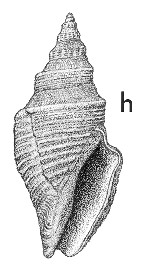
Revised descriptions of New Zealand Cenozoic Mollusca from Beu and Maxwell (1990)

 | Revised descriptions of New Zealand Cenozoic Mollusca from Beu and Maxwell (1990) | 
|
  (Pl. 26h): GS3245, Q8/f9687, Pakaurangi Point, Kaipara Harbour, probably from Pakaurangi Member, Altonian (GNS) |
Beu & Maxwell (1990): Chapter 11; p. 233; pl. 26 h.
Synonymy: Bathytoma sulcata excavata Suter 1917, p. 55
Type species of Austrotoma Finlay, 1924
Classification: Turridae: Pseudotominae
Description: Size moderate for genus (height 30-40 mm), narrowly biconic, spire half total height. Protoconch conical, of about 4 convex whorls, last half whorl with spiral cords crossed by weak axial costellae. Teleoconch of 6 whorls, sharply shouldered at or slightly below middle on spire, sutural ramp concave with weak subsutural fold; last whorl shallowly excavated. Axial sculpture, apart from growth lines, confined to first 3 whorls or so, of narrow costae reaching from shoulder angle to lower suture. Spiral sculpture on ramp of very fine threads reticulated by growth lines, rest of shell with very low, flat-topped cords with interstitial threads; last 2 or 3 whorls with smooth band on peripheral angle. Overall appearance polished. Aperture subrectangular; siphonal notch moderately deep, fasciole not prominent, margining ridge obsolete in some shells. Anal sinus shallowly arcuate, apex below middle of ramp.
Comparison: Records of Austrotoma excavata from localities other than Pakaurangi Point require confirmation. Specimens so identified from White Rock River, South Canterbury (Altonian) are almost entirely smooth except for weak spirals on the lower part of the last whorl, and are probably referrable to A. suteri (Cossmann, 1916) (Altonian, "Broken River"), which was incorrectly synonymised with A. neozelanica by Powell (1942, p. 75). A. excavata is readily distinguished from other species by the early obsolescence of axial costae, by the smooth peripheral band, by the subdued spiral sculpture, and by the weakly defined fasciole. The protoconch also is smaller and narrower than in most other species. A. kaiparaensis (Otaian-Altonian, Pakaurangi Point) is superficially similar but has a larger protoconch and more prominent spiral sculpture.
Distribution: Otaian-Altonian, Pakaurangi Formation, Pakaurangi Point, Kaipara Harbour (type), moderately common in Pakaurangi Member.
Cite this publication as: "A.G. Beu and J.I. Raine (2009). Revised
descriptions of New Zealand Cenozoic Mollusca from Beu and Maxwell (1990). GNS
Science miscellaneous series no. 27."
© GNS Science, 2009
ISBN
978-0-478-19705-1
ISSN 1177-2441
(Included with a PDF facsimile file
copy of New Zealand Geological Survey Paleontological Bulletin 58 in CD version
from: Publications Officer, GNS Science, P.O. Box 30368 Lower Hutt, New
Zealand)